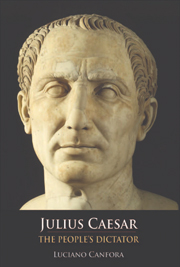Book contents
- Frontmatter
- Contents
- Translators' Note
- Acknowledgements
- Foreword
- PART I FROM SULLA TO CATILINE
- PART II FROM THE TRIUMVIRATE TO THE CONQUEST OF GAUL
- PART III THE LONG CIVIL WAR
- PART IV FROM THE CONSPIRACY TO THE TRIUMPH OF CAESARISM
- 29 Inklings of Conspiracy
- 30 ‘Iure caesus’
- 31 The Lupercalia Drama
- 32 The Dictatorship
- 33 Epicureans in Revolt?
- 34 The Hetairia of Cassius and the Recruitment of Brutus
- 35 A Conspirator's Realism: Cassius Settles for the Second Rank
- 36 Some Unexpected Refusals
- 37 Cicero – an Organiser of the Conspiracy?
- 38 The Serious Mistake of Dismissing the Escort
- 39 The Dynamics of the ‘Tyrannicide’
- 40 ‘Where's Antony?’
- 41 Caesar's Body: How to Turn Victory into Defeat
- 42 The Wind
- Chronology
- Bibliography
- Index
39 - The Dynamics of the ‘Tyrannicide’
from PART IV - FROM THE CONSPIRACY TO THE TRIUMPH OF CAESARISM
Published online by Cambridge University Press: 05 August 2013
- Frontmatter
- Contents
- Translators' Note
- Acknowledgements
- Foreword
- PART I FROM SULLA TO CATILINE
- PART II FROM THE TRIUMVIRATE TO THE CONQUEST OF GAUL
- PART III THE LONG CIVIL WAR
- PART IV FROM THE CONSPIRACY TO THE TRIUMPH OF CAESARISM
- 29 Inklings of Conspiracy
- 30 ‘Iure caesus’
- 31 The Lupercalia Drama
- 32 The Dictatorship
- 33 Epicureans in Revolt?
- 34 The Hetairia of Cassius and the Recruitment of Brutus
- 35 A Conspirator's Realism: Cassius Settles for the Second Rank
- 36 Some Unexpected Refusals
- 37 Cicero – an Organiser of the Conspiracy?
- 38 The Serious Mistake of Dismissing the Escort
- 39 The Dynamics of the ‘Tyrannicide’
- 40 ‘Where's Antony?’
- 41 Caesar's Body: How to Turn Victory into Defeat
- 42 The Wind
- Chronology
- Bibliography
- Index
Summary
… let even the Senate itself wait – and find out at once what important message Artemidorus has for you.
CavafyThe evening before the assassination, Caesar was among the guests at supper at the house of Marcus Lepidus, his magister equitum, and the discussion turned to the question: what kind of death would be best? While the rather strange conversation lingered on this question – a cryptic warning? – Caesar, when his turn came to speak, said that he would by far prefer a sudden and unexpected death. He had expressed the same preference (‘subitam et celerem’) before, in the context of another philosophical dialogue, in the margin of a passage on the death of Cyrus in Xenophon's Cyropaedia. In Cicero's Cato the Elder, written shortly before the murder of Caesar, that passage is translated into Latin with a commentary. It is not at all improbable that, during a reading of Cato the Elder in which Caesar was taking part, the dictator had made that note about his preference for a ‘sudden and unexpected’ death. Obviously this cannot be proven. But the conversation on the eve of the assassination is somewhat enigmatic. There is nothing unusual, given the situation, about conversations consisting of allusive questions or innuendo, designed to pass a veiled message. We should recall the procedure followed by Brutus when he was recruiting followers for the conspiracy.
- Type
- Chapter
- Information
- Julius CaesarThe People's Dictator, pp. 325 - 333Publisher: Edinburgh University PressPrint publication year: 2007



